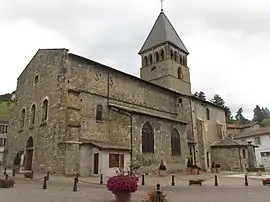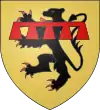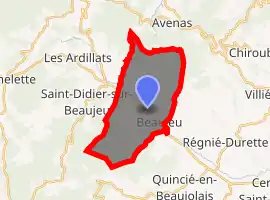Beaujeu, Rhône
Beaujeu (Bôjor/Biôjœr in Arpitan) is a commune of the Rhône department in eastern France.
Beaujeu | |
|---|---|
 The Church of Saint-Nicolas, in Beaujeu | |
 Coat of arms | |
Location of Beaujeu 
| |
 Beaujeu  Beaujeu | |
| Coordinates: 46°09′18″N 4°35′20″E | |
| Country | France |
| Region | Auvergne-Rhône-Alpes |
| Department | Rhône |
| Arrondissement | Villefranche-sur-Saône |
| Canton | Belleville-en-Beaujolais |
| Government | |
| • Mayor (2008–2014) | Sylvain Sotton |
| Area 1 | 17.85 km2 (6.89 sq mi) |
| Population (2017-01-01)[1] | 2,157 |
| • Density | 120/km2 (310/sq mi) |
| Time zone | UTC+01:00 (CET) |
| • Summer (DST) | UTC+02:00 (CEST) |
| INSEE/Postal code | 69018 /69430 |
| Elevation | 277–880 m (909–2,887 ft) (avg. 293 m or 961 ft) |
| 1 French Land Register data, which excludes lakes, ponds, glaciers > 1 km2 (0.386 sq mi or 247 acres) and river estuaries. | |
It lies between Mâcon and Lyon.
Beaujeu gives its name to the famous wine region of Beaujolais (Biôjolês), a former province of France of which it is the historical capital. However it was overtaken in the 14th century by Villefranche-sur-Saône, which remains the main commercial centre of the region.
History
Beaujolais was a semi-autonomous fiefdom of the Lords of Beaujeu. The barony was acquired in the 9th century by Guillaume, Comte du Lyonnais and Count of Forez; on his death, his son Bérard became the first Lord of Beaujeu.
List of rulers
Lords:
- Berard of Beaujeu + c. 966
- Guichard I of Beaujeu c. 966-977
- Humbert I of Beaujeu + c. 977-1016
- Guichard II of Beaujeu c. 1016-1050
- Guichard III of Beaujeu c. 1050-1070
- Humbert II of Beaujeu c. 1070-1102
- Guichard IV of Beaujeu 1102-1137
- Humbert III of Beaujeu 1137-1174
- Humbert IV of Beaujeu 1174-1202
- Guichard V le Grand of Beaujeu 1202-1216
- Humbert V of Beaujeu 1216-1250
- Isabelle de Beaujeu 1250-1297 (married Renaud)
- Renaud I of Forez, count of Forez 1250-1297
- Louis de Beaujeu 1250-1295
- Guichard VI of Beaujeu 1295-1331
- Edouard I of Beaujeu 1331-1351 (Marshal of France)
- Antoine of Beaujeu 1351-1374
- Edouard II of Beaujeu 1374-1400 (+1400 without succession)
After the death of Edouard II, the barony passed to his uncle Louis II, Duke of Bourbon and was used as a title first by members of the Bourbon family and then by the House of Orléans. In 1522, Francis I of France confiscated the title and gave it to his mother Louise of Savoy, but it reverted to the French crown on her death in 1531.
See also
| Wikisource has the text of the 1911 Encyclopædia Britannica article Beaujeu. |
References
- "Populations légales 2017". INSEE. Retrieved 6 January 2020.
| Wikimedia Commons has media related to Beaujeu (Rhône). |